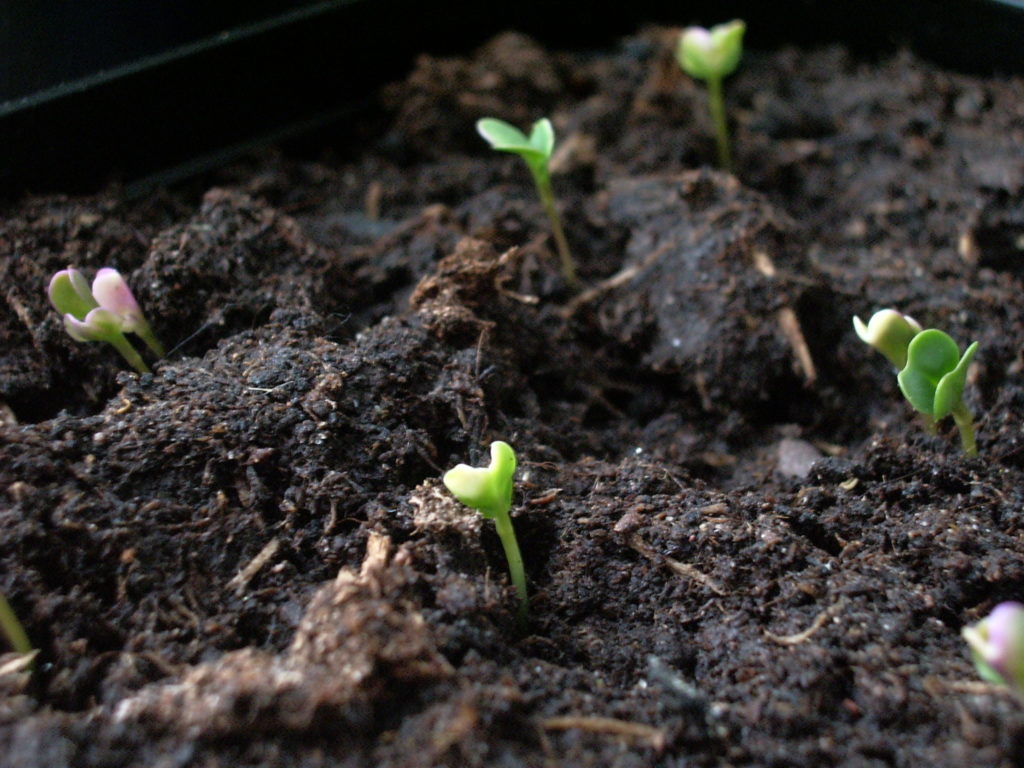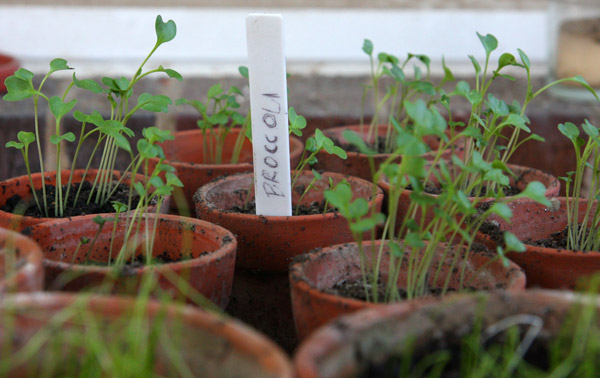Fun fact about broccoli, it is technically a variety of cabbage! Different varieties of wild cabbage were cultivated in the Mediterranean area since the ancient Roman times. Broccoli is closely related to other brassicas like cauliflower, kale, kohlrabi, and many others. Broccoli’s flavor profile and texture depends on preparation. Typically, broccoli has a bitter flavor, but can be a little bit sweeter with a rich taste if thoroughly cooked. Broccoli can be enjoyed steamed, roasted, boiled, or even raw!
How To Plant Broccoli
Broccoli is a biennial that grows best in slightly acidic soil, 6.0 to 7.0 pH. It requires nutrient dense soil with good compost and full sun exposure. Fertilize broccoli with low-nitrogen fertilizer, such as a 5-10-10 npk formula. When starting outside, plant holes half an inch deep and 3 inches apart. Once the broccoli seedlings grow to about two inches in height, thin the seedlings until each plant is twelve inches apart. If transplanting, dig container sized holes and space each broccoli seedling twelve inches apart. The space between your broccoli garden rows should be three feet. If you are starting your broccoli in containers, make sure your containers are large. Broccoli requires a container at least twelve inches wide and deep. While planting in containers, do not plant broccoli in dark colored containers as they will absorb the sun’s rays and make the soil too warm for your broccoli plants for flourish.

It is important to note that broccoli is a cool weather plant and grows well in growing zones 3 to 10. Plant your broccoli in the Spring or Autumn for the best results. Planting your broccoli in the Summer is generally not a good idea because of the intense heat, unless if you live in a region with a very short growing window.
Some companion plants for broccoli include potatoes, lettuce, spinach, dill, basil, thyme, and lavender. It is advised you do not plant different types of hybrid broccoli because the bees will cross pollinate them.
Harvesting Broccoli

Harvesting your broccoli can happen 60 to 80 days from germination. The heads of your broccoli at this time should be tightly packed. Harvest them once they are 4 to 7 inches in height. Cut off the florets keeping a few extra inches of stem. If you notice your broccoli is starting to turn yellow, harvest is immediately. If your broccoli contains side stems, they will blossom into new florets that can be harvested later in the season. If you wish to collect the broccoli seeds for next year, allow your broccoli to turn yellow and to flower. After blooming, cut the stems, separate the seeds, then dry them thoroughly.
After harvesting, fresh broccoli can last up to 7 days. If you plan to store broccoli long term, it is recommended you utilize a blanch and freeze method. Wash your broccoli thoroughly, then place your broccoli heads into a pot of boiling water for 3 minutes. Remove it from the boiling water and submerge in a bucket or pot of ice water. Once blanched the broccoli can last in your freezer up to a year and maintain its freshness.
Broccoli Pests and Diseases
Aphids are a common nuisance that leave sticky honeydew slime and black soot all over your plants. This honeydew slime will also attract ants. The best way to remove aphids is to apply neem oil or an insecticidal soap every few days for several weeks. Also, utilizing native flowers that attract ladybugs to eat the aphids can be a preventative solution.
Cabbage loopers and cabbageworms will eat and completely ravage your broccoli plants. They leave large holes in your plants and can cause stunted growth. Hand remove these caterpillars and apply a bacterial insecticide with Bacillus thuringiensis (BT).
Cabbage root maggots will feed on the roots of broccoli. Wilted or stunted growth is a sign of root maggots. Diatomaceous earth or tin foil rings around the base can help prevent the maggots from reaching the roots. At the end of each season, thoroughly till and rotate your soil.
Clubroot is a type of fungus that will leave your broccoli looking withered, stunted, with yellow-colored leaves and swollen roots. Unfortunately, once clubroot has afflicted your broccoli, the best thing you can do is destroy the plant, disinfect your tools, then rotate your crops.
Downy mildew is a very common fungus that affects vegetables. This mildew leaves a yellowish-brown fluffy dust and distorts the leaves. Applying a copper-based fungicide should help.
Stink bugs will leave yellow to white blotches on the leaves and cluster their eggs on leaf undersides. Flick the bugs away while wearing gloves as they can leave a foul odor then spray your broccoli with insecticidal soap.
White rust is another fungus that will cause chalk-white blisters on the leaves and yellow-green spots on the leaf surfaces. The only thing you can do is destroy the broccoli plant and all crop residues then rotate your crops.

Broccoli Garden Planning
Broccoli is a staple in every garden and a vegetable people either love or hate. Broccoli is very nutritious and contains high doses of fiber, vitamin A, and K. Broccoli is the perfect vegetable to add to every diet. To start planning broccoli in your garden, try our garden planner Hortisketch!

Contact Author
 info@gardensavvy.com
info@gardensavvy.com Recent Posts
- Smart Gardening: How Technology Is Revolutionizing Horticulture
- Understanding Gardening Zones: What You Need to Know
- The Right Tools For Your Gardening And Landscaping Needs
- Maximizing Your Harvest: Square Foot Gardening Chart for Beginners
- Holiday Garden Scents: Plants for Natural Aromatherapy in Your Home









